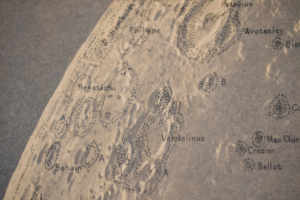Special Collections | Ad Luna, Ad Bibliotheca - College of Charleston Libraries
On this day in 1969, humankind first set foot on the Moon.
Friend of the Library Jim Phillips and Special Collections reveal a unique connection to that momentous event.
On an overcast December morning last year, semi-retired physician Jim Phillips ‘73 donated to the College Libraries an atlas of another world.
Earth’s nearest neighbor, that is: the Moon.
Special Collections is now home to Carte photographique et systematique de la Lune, the first photographic atlas to map the moon’s entire visible surface.
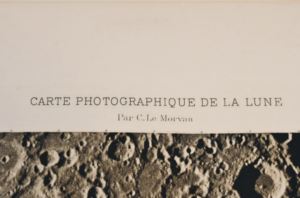 “The large print format and fine detail of the photographs bring the Moon’s features up close,” said George Chartas, associate professor of astronomy and director of the College’s Observatory. “The light graininess reminds you of the pre-digital era when photographs were taken with film cameras and developed in dark rooms.”
“The large print format and fine detail of the photographs bring the Moon’s features up close,” said George Chartas, associate professor of astronomy and director of the College’s Observatory. “The light graininess reminds you of the pre-digital era when photographs were taken with film cameras and developed in dark rooms.”
Today, high-resolution images of the Moon’s surface are available at one’s fingertips, and tracking the celestial body’s movements is as easy as opening the Google Sky app. But upon its 1914 publication, the atlas represented the bleeding edge of lunar photography and scientific rigor.
For some perspective, consider that capturing clear images of distant, moving objects is difficult even today with digital cameras—try to photograph the Moon with an iPhone and the likeliest result is a blurred or blackened mess. Now flashback more than a century to when photography remained a complicated mechanical process and the object in question is 238,900 miles away.
“The images are so precise and revealing that they make you aware of just how technologically advanced the work was for its time, ahead of its time in fact,” Greene said.
So striking are the atlas’ images that it wasn’t only fellow stargazers pulled into its orbit.
“When these precise photographs of the moon were taken and circulated in the early 1900’s, they were not only useful to scientists but inspired a large number of artists, painters and writers,” Chartas said.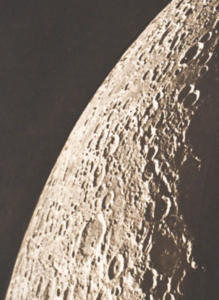
Carte photographique et systematique de la Lune was unique in its organization. Previous publications featured lunar photographs, though none were comprehensive. This was the innovation of the atlas’ editor, French astronomer Charles Morvan.
Repurposing images captured at theParis Observatory, Morvan devised a systematic arrangement: The atlas’ first 24 images depict the phases between anew Moon and full, and the remaining 24 capture the reverse phases. When displayed together in a grid, the 48 images form complete views of the waxing and waning Moon.
The atlas’ scientific significance isn’t limited to the early 20th century. When President John F. Kennedy promised to land a man on the moon, the question was begged: Land where, exactly?
“Detailed photographs like these and others to follow were important in providing the accurate topology of the Moon that would later allow humans to land safely,” Chartas said. “The atlas is still amazing to look through today and an important resource for our students.”
Enchantment with the Moon is as old as humanity, inspiring craned-necks since time immemorial. This universal human interest is reflected in the holdings of Special Collections, where the atlas joins myriad lunar items.
“The gift extends and magnifies the many medieval to modern images—engravings, maps, woodcuts and lithographs—of the moon already given us,” Greene said. “In 2017, when NASA scientists encamped here for the total eclipse of the sun, they were almost as transfixed by the materials in the collection as they were of the splendors of the eclipse itself.”
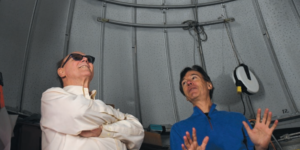
Jim Phillips and George Chartas.
For longtime Friend of the Library Jim Phillips, this lunar interest has featured prominently throughout his life.
“I was given my first telescope by my Mom in September 1965,” Phillips said. “I have owned and used telescopes ever since. I have always kept journals of my observations.”
With a personal observatory in his downtown Charleston home, Phillips daily tracks and photographs the Moon.
“When my wife and I were looking for a new home, my only requirement was that it have a southern facing window,” Phillips said. The atlas joins a large collection of original maps of the Moon from the 18th and 19th centuries previously donated by Phillips.“I truly believe this collection of early lunar books and maps is one of the very best in the entire country.”
During his December trip to Special Collections, Phillips met with Chartas for a private tour of the Observatory, viewing images of the Moon captured by the College’s 24-inch telescope—the most powerful in South Carolina.
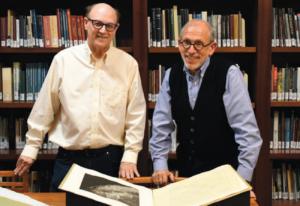
Jim Phillips and Harlan Greene.
Their discussion of the atlas and all things lunar harkened back to a long-ago connection between an astronomy professor and Charleston resident. In the 1880s, Frank Fisher, a cashier at the South Carolina Railroad Company, kept his own astronomical observations and corresponded at length with the College’s Lewis R. Gibbes. Fisher’s drawings, charts, and diagrams are held by Special Collections.
“From all the images of celestial objects that we have captured with our new tele-scope the one that has received the most ‘likes’ is an image of the super blood wolf moon taken during the total lunar eclipse of January 20, 2019,” Chartas said.
“There is something mystical about the moon that captures the imagination of the public.”

